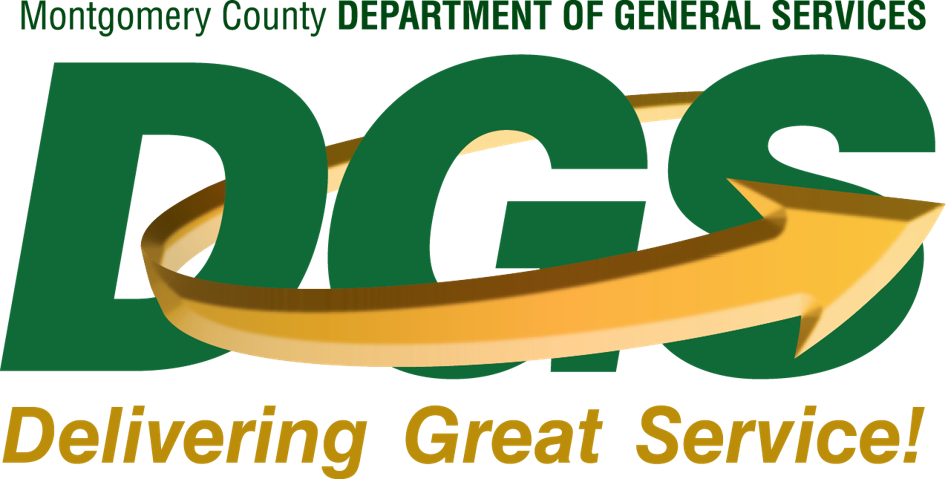The ADA Compliance Team - What We Do
Title II of the ADA requires that state and local government entities do not discriminate against people with disabilities in their programs, services and activities. The goal of the ADA Compliance Team is to coordinate Montgomery County government’s overall ADA compliance efforts.
Training and Technical Assistance
 The ADA Team provides training and technical assistance on a wide range of ADA and accessibility issues. The Team coordinates the County’s Sign Language interpreting services and its assistive listening device contract and maintains an intranet resource library on accessibility for County staff. The Team’s Capital Projects Manager serves as a subject matter expert on building accessibility. The ADA Compliance Manager serves as the policy expert, monitors federal rulemaking related to Title II and other disability related legislation, and is an ex-officio member of the Commission on People with Disabilities.
The ADA Team provides training and technical assistance on a wide range of ADA and accessibility issues. The Team coordinates the County’s Sign Language interpreting services and its assistive listening device contract and maintains an intranet resource library on accessibility for County staff. The Team’s Capital Projects Manager serves as a subject matter expert on building accessibility. The ADA Compliance Manager serves as the policy expert, monitors federal rulemaking related to Title II and other disability related legislation, and is an ex-officio member of the Commission on People with Disabilities.
Comments, Questions and Complaints
The ADA Team is always available to provide information on the accessibility of County government buildings, facilities, programs and services. We will also refer you to other resources if your issue or concern does not involve a County government facility, program or service.
Montgomery County is committed to providing accessible programs and services and to providing prompt and equitable resolution of Title II problems. In most cases the ADA Team can resolve problems and concerns quickly and informally. When that is not possible, a formal internal grievance procedure has been established. The ADA Compliance manager, Matthew Barkley, is responsible for investigating and resolving those complaints. In addition to the internal grievance policy, individuals may file an administrative complaint with a designated federal agency or with the Department of Justice ( www.ada.gov) and have the right to file a private lawsuit for injunctive relief and damages.
Panel title
For information, to make a comment, ask a question or file a grievance please contact:
Matthew Barkley, ADA Compliance Manager
Department of General Services
Montgomery County
101 Monroe Street, 9th floor
Rockville, MD 20850
(Voice) 240-777-6197
adacompliance@montgomerycountymd.gov
Please be sure to provide as much detail on your question or concern as possible and please be sure to let us know how to contact you so that we can provide you with the best service.
New Construction
Although the Americans with Disabilities Act has been in effect since 1992, it is very common to find non-compliant features even in new construction. The Department of Justice (DOJ) has published a document, First Steps Toward Solving Common ADA Problems that highlights some common errors.
In order to ensure that new and renovated County government buildings are fully compliant with the applicable ADA requirements as well as with the more stringent Maryland Accessibility Code, the Department of General Services initiated an ongoing review process. Using accessibility consultants with nationally recognized expertise, projects are reviewed at key points during the design and construction of the building. There are four reviews during the design process; two site visits during construction, a punch list walk through just before substantial completion and a post-construction survey. The accessibility experts attend key meetings and are available to answer questions and provide technical assistance during the design and construction process. Our goal is to identify accessibility and compliance issues at the earliest point possible both to ensure accessibility for people with disabilities and to avoid later costly remediation work.
Examples of features that we assess for accessibility
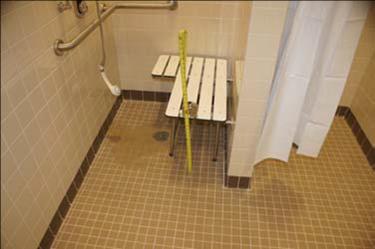 Checking the features in an accessible shower at building that is near completion.
Checking the features in an accessible shower at building that is near completion.
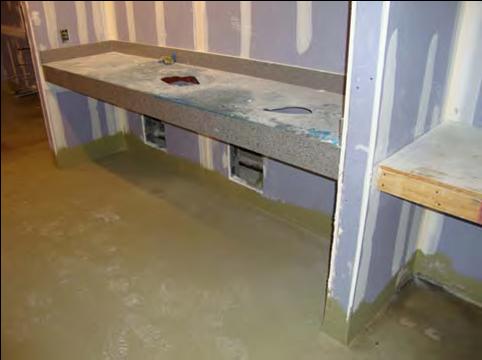 This is an example of a restroom under construction. During the site visit, the counter would be surveyed to ensure that there is sufficient clearance for wheelchair users.
This is an example of a restroom under construction. During the site visit, the counter would be surveyed to ensure that there is sufficient clearance for wheelchair users.
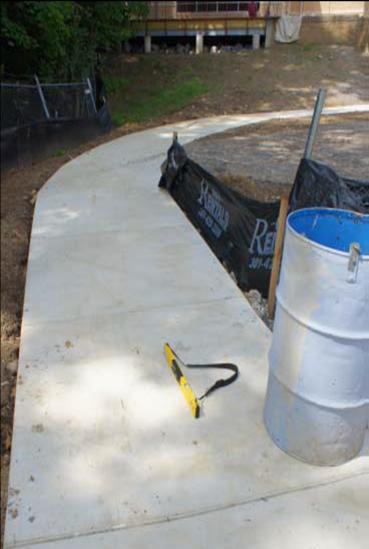 This is a path under construction at a recreation center. The slope and cross slope of the path would be surveyed to ensure accessibility.
This is a path under construction at a recreation center. The slope and cross slope of the path would be surveyed to ensure accessibility.
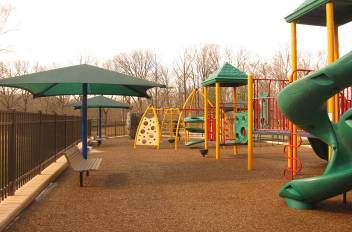 This photo shows an accessible playground that meets the new ADA requirements for recreational facilities. The playground is located at the White Oak Community Center in Silver Spring.
This photo shows an accessible playground that meets the new ADA requirements for recreational facilities. The playground is located at the White Oak Community Center in Silver Spring.
Project Access
In, 2010 Montgomery County signed a Project Civic Access Settlement Agreement with the U.S. Department of Justice (DOJ). Project Civic Access is an on-going, proactive program designed to ensure that counties, cities, and cities throughout the country comply with the ADA by eliminating physical and communication barriers.
The ADA Compliance Team is now working to address all of the findings included in the Settlement Agreement. The Team is also surveying all remaining County buildings and facilities to identify barriers and to develop work plan to remove these barriers in the future. The Team’s work ranges from small projects such as moving a grab bar in a restroom to larger projects such as correcting the slope and cross slope on a long route into a building to redesigning and fully renovating inaccessible space. All of these projects improve access for people with disabilities at County buildings and other facilities.
The County’s Settlement Agreement with DOJ is available for review at DOJ's web site. Information on the findings and remediation schedule for specific buildings are included in Attachments I, J, and K. Attachment M is the key to the required action steps. For more information on this ADA Team’s work or to provide suggestions or comments, please contact adacompliance@montgomerycountymd.gov
Examples of common ADA problems
Parking Area before Remediation
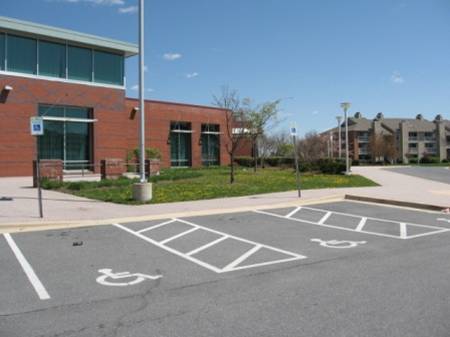 Three spaces are designated for disabled persons, but none is wide enough with a wide access aisle (slant lines), to be van-accessible.
Three spaces are designated for disabled persons, but none is wide enough with a wide access aisle (slant lines), to be van-accessible.
Parking Area after Remediation
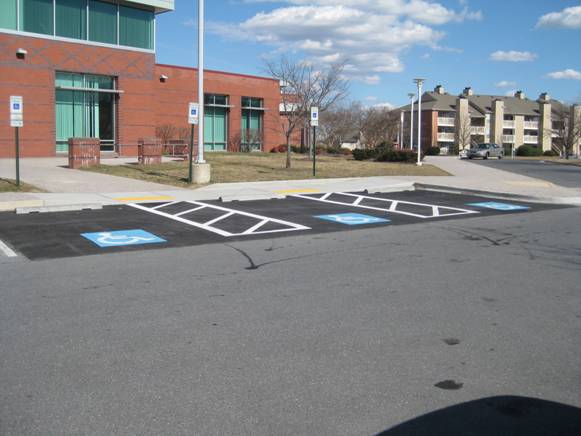 The County repainted the lines to define a wide enough space. The newly van-accessible space, at the left, is 11 feet (132 inches) wide, with a 5-foot (60-inch) access aisle on the right. An 8-foot wide parking space served by an adjacent 8-foot-wide access aisle would be permitted as an exception under the 2010 ADA Standards (502.2); however, a sign marking the aisle as a no-parking space would then be required (Advisory 502.3), and as can be seen from the photo this sign would encroach on the pedestrian access route to the building.
The County repainted the lines to define a wide enough space. The newly van-accessible space, at the left, is 11 feet (132 inches) wide, with a 5-foot (60-inch) access aisle on the right. An 8-foot wide parking space served by an adjacent 8-foot-wide access aisle would be permitted as an exception under the 2010 ADA Standards (502.2); however, a sign marking the aisle as a no-parking space would then be required (Advisory 502.3), and as can be seen from the photo this sign would encroach on the pedestrian access route to the building.
Original Threshold with ¾” Non-sloped Rise
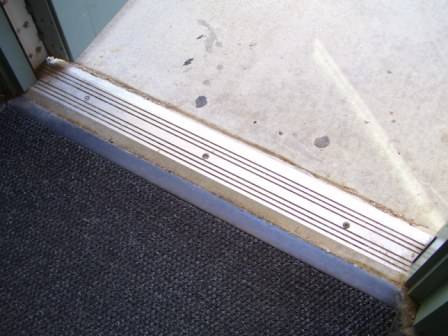 The threshold has an abrupt ¾-inch rise which make it difficult for people with wheelchairs, walkers and other mobility devices to enter the building.
The threshold has an abrupt ¾-inch rise which make it difficult for people with wheelchairs, walkers and other mobility devices to enter the building.
Accessible Threshold with a Ramp
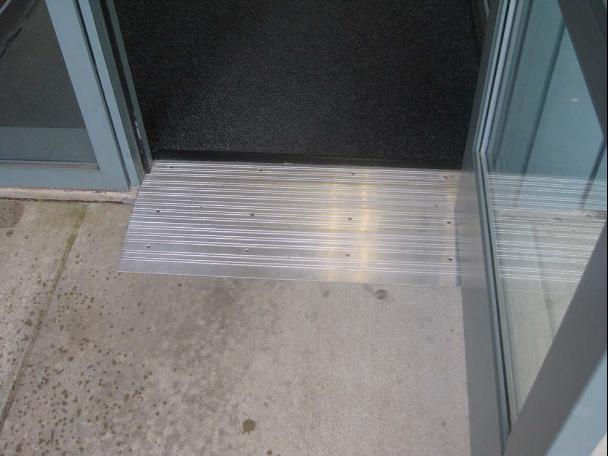 A ramp was added so people using mobility devices can easily access the building.
A ramp was added so people using mobility devices can easily access the building.
The Water Fountain is Undetectable to a Person Using a Cane
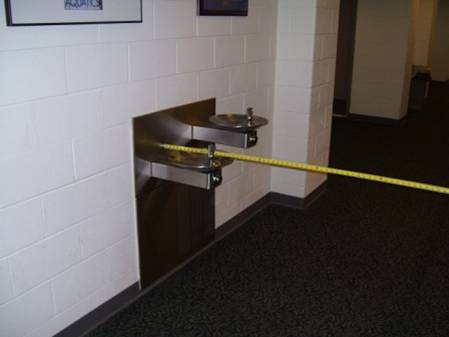 This water fountain protrudes into the hallway. A person who is blind and uses a cane for navigation normally sweeps the cane in order to make sure there are no objects in blocking the path of travel. The cane will not detect this water fountain so this can be dangerous.
This water fountain protrudes into the hallway. A person who is blind and uses a cane for navigation normally sweeps the cane in order to make sure there are no objects in blocking the path of travel. The cane will not detect this water fountain so this can be dangerous.
Cane-detectable Barriers around the Water Fountain
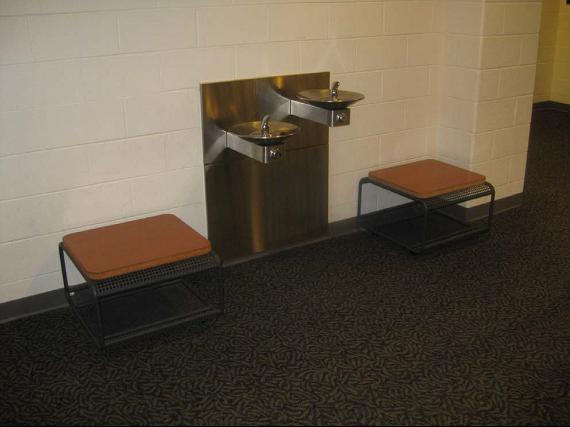 Here a small table was permanently installed on either side of the water fountain. A person using a cane to find their way will now be able to detect the table and avoid hitting the water fountain.
Here a small table was permanently installed on either side of the water fountain. A person using a cane to find their way will now be able to detect the table and avoid hitting the water fountain.
Parking Lot Before Remediation
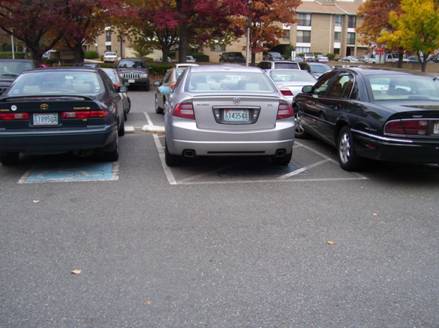
- The number of spaces for persons with disabilities was inadequate
- In some, the degree of slope was excessive
- The spaces were not correctly marked with vertical signs
- Cars without MVA disability tags were parked in spaces reserved for disabled persons and in the marked access aisles between them
- There was no safe and accessible path of travel from these spaces to the public right-of-way (sidewalk)
Parking Lot After Remediation
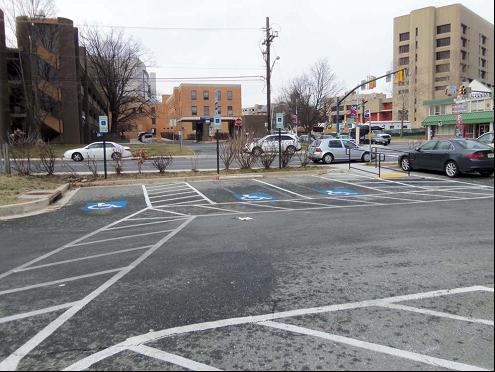
- The number and size of the spaces has been increased
- Some spaces were added closer to the sidewalk
- The excessive slope was corrected
- New signage was added to mark the spaces and the access aisle
- A well defined path of travel with a ramp and handrail was added to the lot

